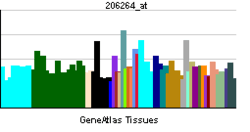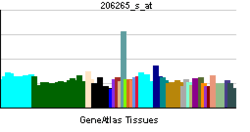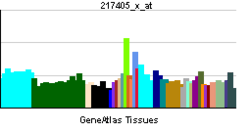GPLD1
| View/Edit Human | View/Edit Mouse |
Phosphatidylinositol-glycan-specific phospholipase D is an enzyme that in humans is encoded by the GPLD1 gene.[3][4]
Many proteins are tethered to the extracellular face of eukaryotic plasma membranes by a glycosylphosphatidylinositol (GPI) anchor. The GPI-anchor is a glycolipid found on many blood cells. The protein encoded by this gene is a GPI degrading enzyme. Glycosylphosphatidylinositol specific phospholipase D1 hydrolyzes the inositol phosphate linkage in proteins anchored by phosphatidylinositol glycans, thereby releasing the attached protein from the plasma membrane.[4]
Interactions
GPLD1 has been shown to interact with Apolipoprotein A1[5] and APOA4.[5]
References
- ↑ "Human PubMed Reference:".
- ↑ "Mouse PubMed Reference:".
- ↑ Schofield JN, Rademacher TW (Dec 2000). "Structure and expression of the human glycosylphosphatidylinositol phospholipase D1 (GPLD1) gene". Biochim Biophys Acta. 1494 (1–2): 189–94. doi:10.1016/s0167-4781(00)00194-9. PMID 11072085.
- 1 2 "Entrez Gene: GPLD1 glycosylphosphatidylinositol specific phospholipase D1".
- 1 2 Deeg, M A; Bierman E L; Cheung M C (Mar 2001). "GPI-specific phospholipase D associates with an apoA-I- and apoA-IV-containing complex". J. Lipid Res. United States. 42 (3): 442–51. ISSN 0022-2275. PMID 11254757.
Further reading
- Hoener MC, Brodbeck U (1992). "Phosphatidylinositol-glycan-specific phospholipase D is an amphiphilic glycoprotein that in serum is associated with high-density lipoproteins". Eur. J. Biochem. 206 (3): 747–57. doi:10.1111/j.1432-1033.1992.tb16981.x. PMID 1606959.
- Scallon BJ, Fung WJ, Tsang TC, et al. (1991). "Primary structure and functional activity of a phosphatidylinositol-glycan-specific phospholipase D". Science. 252 (5004): 446–8. doi:10.1126/science.2017684. PMID 2017684.
- Metz CN, Brunner G, Choi-Muira NH, et al. (1994). "Release of GPI-anchored membrane proteins by a cell-associated GPI-specific phospholipase D". EMBO J. 13 (7): 1741–51. PMC 395007
 . PMID 7512501.
. PMID 7512501. - Jinnai H, Nakamura S (2000). "Characterization of phospholipase D activation by GM2 activator in a cell-free system". Kobe Journal of Medical Sciences. 45 (3–4): 181–90. PMID 10752311.
- Deeg MA, Bierman EL, Cheung MC (2001). "GPI-specific phospholipase D associates with an apoA-I- and apoA-IV-containing complex". J. Lipid Res. 42 (3): 442–51. PMID 11254757.
- Tang J, Li W (2002). "[Methodological study on the assay of glycosylphosphatidylinositol-specific phospholipase D activity in serum]". Hunan Yi Ke Da Xue Xue Bao. 24 (2): 119–22. PMID 11938765.
- Slomiany A, Nishikawa H, Slomiany BL (2002). "Screening and modulation of extracellular signals by mucous barrier. Serum glycosylphosphatidylinositol phospholipase D (GPI-PLD) releases protective mucous barrier from oral mucosa". J. Physiol. Pharmacol. 53 (1): 21–38. PMID 11939716.
- Jaworek J, Bonio J, Leja-Szpa A, et al. (2002). "Sensory nerves in central and peripheral control of pancreatic integrity by leptin and melatonin". J. Physiol. Pharmacol. 53 (1): 51–74. PMID 11939719.
- Deeg MA, Bowen RF (2002). "Phosphorylation decreases trypsin activation and apolipoprotein al binding to glycosylphosphatidylinositol-specific phospholipase D". Biochem. Cell Biol. 80 (2): 253–60. doi:10.1139/o02-004. PMID 11989719.
- Xiaotong H, Hannocks MJ, Hampson I, Brunner G (2002). "GPI-specific phospholipase D mRNA expression in tumor cells of different malignancy". Clin. Exp. Metastasis. 19 (4): 291–9. doi:10.1023/A:1015545407700. PMID 12090469.
- Magnusson P, Sharp CA, Farley JR (2003). "Different distributions of human bone alkaline phosphatase isoforms in serum and bone tissue extracts". Clin. Chim. Acta. 325 (1–2): 59–70. doi:10.1016/S0009-8981(02)00248-6. PMID 12367767.
- Strausberg RL, Feingold EA, Grouse LH, et al. (2003). "Generation and initial analysis of more than 15,000 full-length human and mouse cDNA sequences". Proc. Natl. Acad. Sci. U.S.A. 99 (26): 16899–903. doi:10.1073/pnas.242603899. PMC 139241
 . PMID 12477932.
. PMID 12477932. - Tang JH, Gu SL, Zhang XJ (2003). "[Preliminary study of the gene structure of human glycosylphosphatidylinositol specific phospholipase D]". Hunan Yi Ke Da Xue Xue Bao. 26 (2): 95–7. PMID 12536633.
- Mungall AJ, Palmer SA, Sims SK, et al. (2003). "The DNA sequence and analysis of human chromosome 6". Nature. 425 (6960): 805–11. doi:10.1038/nature02055. PMID 14574404.
- Kurtz TA, Fineberg NS, Considine RV, Deeg MA (2004). "Insulin resistance is associated with increased serum levels of glycosylphosphatidylinositol-specific phospholipase D". Metab. Clin. Exp. 53 (2): 138–9. doi:10.1016/j.metabol.2003.09.004. PMID 14767861.
- Gerhard DS, Wagner L, Feingold EA, et al. (2004). "The Status, Quality, and Expansion of the NIH Full-Length cDNA Project: The Mammalian Gene Collection (MGC)". Genome Res. 14 (10B): 2121–7. doi:10.1101/gr.2596504. PMC 528928
 . PMID 15489334.
. PMID 15489334. - Lugli EB, Pouliot M, Portela Mdel P, et al. (2005). "Characterization of primate trypanosome lytic factors". Mol. Biochem. Parasitol. 138 (1): 9–20. doi:10.1016/j.molbiopara.2004.07.004. PMID 15500911.
- Everett PB, Senogles SE (2005). "D3 dopamine receptor activates phospholipase D through a pertussis toxin-insensitive pathway". Neurosci. Lett. 371 (1): 34–9. doi:10.1016/j.neulet.2004.08.033. PMID 15500962.
- Mead KI, Zheng Y, Manzotti CN, et al. (2005). "Exocytosis of CTLA-4 is dependent on phospholipase D and ADP ribosylation factor-1 and stimulated during activation of regulatory T cells". J. Immunol. 174 (8): 4803–11. doi:10.4049/jimmunol.174.8.4803. PMID 15814706.
This article is issued from Wikipedia - version of the 5/31/2016. The text is available under the Creative Commons Attribution/Share Alike but additional terms may apply for the media files.


